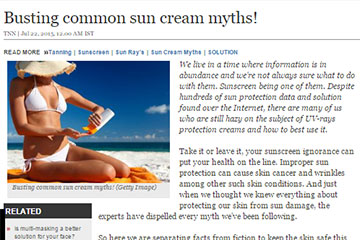
Busting common sun cream myths
DERMATOLOGY
The Times of India
We live in a time where information is in abundance and we’re not always sure what to do with them. Sunscreen being one of them. Despite hundreds of sun protection data and solution found over the Internet, there are many of us who are still hazy on the subject of UV-rays protection creams and how to best use it.
Take it or leave it, your sunscreen ignorance can put your health on the line. Improper sun protection can cause skin cancer and wrinkles among other such skin conditions. And just when we thought we knew everything about protecting our skin from sun damage, the experts have dispelled every myth we’ve been following.
So here we are separating facts from fiction to keep the skin safe this summer. Consultant dermatologist Dr Noor Almaani dispels every myth about your sunscreen, as reported by Daily Mail.
There are two types of ultraviolet lights: UVB, which causes sunburn, and UVA, which penetrates the skin more deeply and can cause wrinkles. Both UVB and UVA rays can lead to skin cancer.
MYTH – Cloud protect you from sun’s harmful rays
This is a major mistake millions are guilty of making – ditching the sun cream because it is cloudy outside. The myth is that clouds offer protection against the sun’s harmful rays. But the experts disagree. Dr Almaani says the idea simply is not true. “UV rays have the same intensity during daylight hours the whole year round, it is not weather or season dependent.” Further adding: “They can seep through clouds so even on overcast days, when it’s grey and miserable, it’s important to wear SPF.”
MYTH – Expensive sun cream offers more protection
The assumption that the more you pay for a sun cream, the more protection it offers is anything but true, which the expert agrees with.
MYTH – UVA rays are only measured by a star rating
The star rating – where five stars indicates the greatest level of protection against UVA rays – was an initiative introduced by retailers.
MYTH – Sun cream doesn’t go out of date
False. Sun cream does have a shelf life and it should be adhered to. If you use out-of-date sunscreen, you won’t be getting the levels of protection you think you are.
MYTH – You can’t catch the sun through the car window
Another common misconception, is the idea that you can’t catch a tan through glass. Many drivers across the world think their car windscreen will protect their skin. But, Dr Almaani says, “This is simply not true. As mentioned previously, UVB rays contain healthy vitamin D, however, these rays can’t penetrate glass unlike the more harmful UVA rays. This means, then, that people tend to age more on the side of their bodies that is often exposed to sunlight and the deeper layers of skin are being harmed.”
“So if you sit near a window at work or drive a lot for your job then make sure you’re using lashings of SPF to protect your skin and prevent premature ageing.”
MYTH – Once-a-day sun creams work
“For continued sun protection, it is important to reapply sun cream,” Dr Almaani suggests. “This also applies to water-resistant sun cream and the so-called ‘once-a-day’ preparations, as their efficacy will depend on whether the right amount is applied, to give the protection specified on the bottle.”
“Also sunscreens, particularly chemical absorbers, degrade gradually on sun-exposure with reduced effect and this applies to ‘once daily’ applications.”
Further explaining how the sun cream wear off, Dr Almaani adds, “In addition, water contact, sweating and rubbing will render the cream less effective and therefore ‘long-wear’ sunscreens can give a false sense of adequate protection with less careful sun protection practices.”




